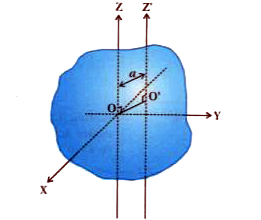State and prove theorem of parallel axis. Solution in Gujrati
The moment of inertia of a body about any axis is equal to the sum of the moment of inertia of the body about a parallel axis passing through its centre of mass and the product of its mass and the square of the distance between the two parallel axes.

As shown in figure Z and Z. are two parallel axes separated by a distance a. ∴OO.=a
The Z-axis passes through the centre of mass O of the rigid body.
From theorem of parallel axes
IZ=IZ+Ma2orIZ=IC+M(OO.)2
where IZandIZ are the moments of inertia of the body about the Z and Z. axes respectively.
M = total mass of the body
a = perpendicular distance between the two parallel axes.
If moment of inertia of object of any shape about the axis passing through its centre is given, then moment of inertia about the axis parallel to the axis passing through its centre can be determined.
Topper's Solved these Questions
- SYSTEMS OF PARTICLES AND ROTATIONAL MOTIONBOOK - KUMAR PRAKASHANCHAPTER - SYSTEMS OF PARTICLES AND ROTATIONAL MOTIONEXERCISE - SECTION-A HOTS
3 Videos
- SYSTEMS OF PARTICLES AND ROTATIONAL MOTIONBOOK - KUMAR PRAKASHANCHAPTER - SYSTEMS OF PARTICLES AND ROTATIONAL MOTIONEXERCISE - SECTION-A (TRY YOURSELF (VSQs))
94 Videos
- QUESTIONS ASKED IN JEE - 2020 BOOK - KUMAR PRAKASHANCHAPTER - QUESTIONS ASKED IN JEE - 2020 EXERCISE - Question
16 Videos
- THERMAL PROPERTIES OF MATTERBOOK - KUMAR PRAKASHANCHAPTER - THERMAL PROPERTIES OF MATTEREXERCISE - Question Paper (Section - D) (Answer following in brief :) Each carry 4 marks
1 Videos
Similar Questions
What is torque? Explain the torque acting on a particle.
View SolutionWhat is a rigid body ? Explain the differences between rigid body and solid body.
View SolutionA non-isotropic solid metal cube has coefficient of linear expansion as 5×10−5/∘C along the x-axis and 5×10−6/∘C along y-axis and z-axis. If the coefficient of volumetric expansion of the solid is n×10−6/∘C then the value of n is....
View SolutionIn an experiment on the specific heat of a metal, a 0.20 kg block of the metal at 150∘C is dropped in a copper calorimeter (of water equivalent 0.025 kg) containing 150 cm3 of water at 27∘C. The final temperature is 40∘C. Compute the specific heat of the metal. If heat losses to the surroundings are not negligible, is your answer greater or smaller than the actual value for specific heat of the metal ?
View SolutionState and prove theorem of parallel axes.
View SolutionState and prove parallel axis theorem.
View SolutionState and prove perpendicular axis theorem
View SolutionState and prove parallel axis theorem
View SolutionState and prove perpendicular axis theorem.
View SolutionState and prove parallel axis theorem
View SolutionState the theorem of parallel axis.
View SolutionState and explain parallel axis theorem and perpendicular axis theorem.
View SolutionState and prove parallel axis theorem
View SolutionState and prove perpendicular axis theorem.
View SolutionState and prove parallel axis theorem
View SolutionState and prove perpendicular axis theorem.
View Solution
